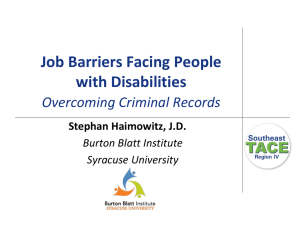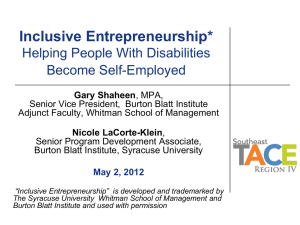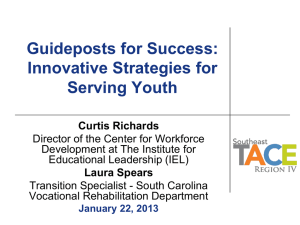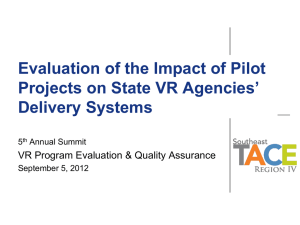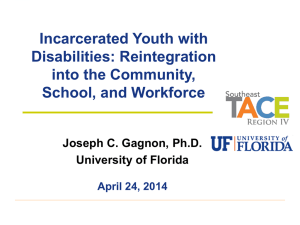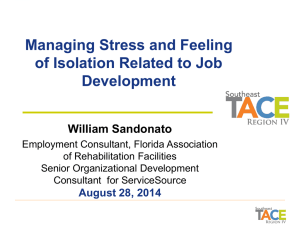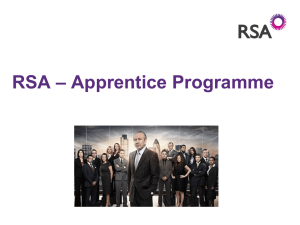How to Read an Eye Report
advertisement
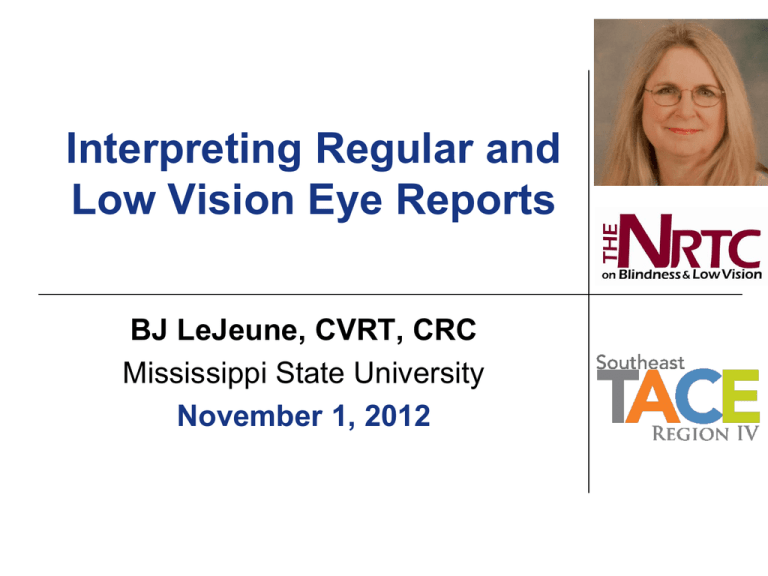
Interpreting Regular and Low Vision Eye Reports BJ LeJeune, CVRT, CRC Mississippi State University November 1, 2012 2 Resources that Help • Dictionary of Eye Terminology www.eyeglossary.net • Riordan P. & Whitcher, J.P. (2008).Vaughn & Asbury’s General Ophthalmology TACE Center: Region IV, a project of the Burton Blatt Institute. Funded by RSA Grant # H264A080021. © 2012 3 Two Types of Eye Exams Regular Eye Exam Low Vision Exam TACE Center: Region IV, a project of the Burton Blatt Institute. Funded by RSA Grant # H264A080021. © 2012 4 The goal of a regular eye exam • Check general eye health • To diagnose any eye problems • To develop a treatment plan to address disease and • refraction errors To maximize vision using traditional glasses or contact lenses or refer for lasik surgery TACE Center: Region IV, a project of the Burton Blatt Institute. Funded by RSA Grant # H264A080021. © 2012 What constitutes a “regular” eye exam? SOAP format • S = subjective • O = objective • A = assessment • P = plan TACE Center: Region IV, a project of the Burton Blatt Institute. Funded by RSA Grant # H264A080021. © 2012 5 6 Subjective • Patient History “What’s going on?” “Where is problem?” – (Which eye?) “When did it start?” “Why?” – (Did something cause problem?) Modifiers Severity?, How often?, Does anything help? TACE Center: Region IV, a project of the Burton Blatt Institute. Funded by RSA Grant # H264A080021. © 2012 7 Subjective (cont.) Medical History – Health history Meds - Rx, OTC, vitamins/supplements Previous eye care Brief Psychological evaluation O X 3 = oriented to person, place and time (date, year, etc.) – Medicare requires this for a comprehensive exam TACE Center: Region IV, a project of the Burton Blatt Institute. Funded by RSA Grant # H264A080021. © 2012 8 Objective Testing • Visual acuity = VA s = without correction, c = with correction DVA = distance, NVA = near OD = right eye, OS = left eye, OU = both eyes BVA = Best Corrected Visual Acuity Charts Snellen (or POC = “Project-o-Chart) = standard chart – gives 20/XX #’s - 1st 20 = test distance (20 feet). 2nd number = size of letter seen. TACE Center: Region IV, a project of the Burton Blatt Institute. Funded by RSA Grant # H264A080021. © 2012 9 Snellen Chart TACE Center: Region IV, a project of the Burton Blatt Institute. Funded by RSA Grant # H264A080021. © 2012 10 Objective Testing (cont.) • Pupils • PERRLA = Pupils equally round and reactive to light and accommodation +/- APD (or MG) = positive/negative afferent pupillary reaction (or Marcus-Gunn pupils) relative afferent pupillary defect (RAPD) EOM = Extra Ocular Muscles or Eye movements S & F = Smooth and Full Restricted – Which eye in which quadrant of gaze (up, down, left, right or combinations) TACE Center: Region IV, a project of the Burton Blatt Institute. Funded by RSA Grant # H264A080021. © 2012 11 Objective (cont.) • Eye alignment • Tropia = constant eye turn Phoria = intermittent eye turn Eso =in, Exo = out Visual Fields – show field loss Confrontations = peripheral FTFC = Full to Finger Counting in all quadrants Can be used to map central or peripheral loss TACE Center: Region IV, a project of the Burton Blatt Institute. Funded by RSA Grant # H264A080021. © 2012 12 Objective (cont.) • Perimetry – measurement of the visual fields – Patient • • must be able to fix on an object Automated Fields (Humphrey, Dicon, Octopus, etc.) Static perimetry Gives detailed view of loss Can be used for central or peripheral loss Manual Fields (Goldmann) Kinetic (moving) Evaluates the entire visual field TACE Center: Region IV, a project of the Burton Blatt Institute. Funded by RSA Grant # H264A080021. © 2012 13 Humphrey Visual Field Test TACE Center: Region IV, a project of the Burton Blatt Institute. Funded by RSA Grant # H264A080021. © 2012 14 Results of Field tests TACE Center: Region IV, a project of the Burton Blatt Institute. Funded by RSA Grant # H264A080021. © 2012 15 Amslar Grid TACE Center: Region IV, a project of the Burton Blatt Institute. Funded by RSA Grant # H264A080021. © 2012 16 Objective Continued • Refraction • • Manifest = traditional Cycloplegic = dilated Jaegar Near Vision chart Intraocular pressures (IOP) or tonometry Combined with dilated fundus exam to test for glaucoma Normal pressures 14-20 TACE Center: Region IV, a project of the Burton Blatt Institute. Funded by RSA Grant # H264A080021. © 2012 17 Objective (cont.) • SLE = Slit Lamp Exam (Biomicroscopy) Examination of external structures of eye Lids/lashes, conjunctiva, cornea, anterior chamber, iris. Lens TACE Center: Region IV, a project of the Burton Blatt Institute. Funded by RSA Grant # H264A080021. © 2012 18 Slit Lamp TACE Center: Region IV, a project of the Burton Blatt Institute. Funded by RSA Grant # H264A080021. © 2012 19 Dilated Fundus Exam • DFE =Dilated Fundus Exam -internal eye exam • C/D = cup to disc ratio of optic nerve • V V = blood vessels • Vitreous • Periphery TACE Center: Region IV, a project of the Burton Blatt Institute. Funded by RSA Grant # H264A080021. © 2012 20 Dilated Fundus Exam TACE Center: Region IV, a project of the Burton Blatt Institute. Funded by RSA Grant # H264A080021. © 2012 21 Fundus View of Diseased Retina TACE Center: Region IV, a project of the Burton Blatt Institute. Funded by RSA Grant # H264A080021. © 2012 22 Jaegar Near Vision Test TACE Center: Region IV, a project of the Burton Blatt Institute. Funded by RSA Grant # H264A080021. © 2012 23 Intra Ocular Pressure • IOP 10-21 normal • Glaucoma is now diagnosed by changes in the disk to ratio, not simply intra-ocular pressure readings TACE Center: Region IV, a project of the Burton Blatt Institute. Funded by RSA Grant # H264A080021. © 2012 24 The Numbers • IOP = intraocular pressure – measured by tonometry – applanation, non-contact (“air puff”), old style = Schiotz Expressed in mmHg (millimeters of mercury – just like a barometer) Glaucoma – pressure in the eye too high for the eye to handle. Normal range = 10 – 21 mmHg. Can have normal pressure and still have glaucoma (GLC). Can have higher than normal pressures and NOT have glaucoma. TACE Center: Region IV, a project of the Burton Blatt Institute. Funded by RSA Grant # H264A080021. © 2012 25 Assessment • Also called Impression What the doctor thinks is going on Examples = AMD (macular degeneration), GLC (glaucoma), BDR (non-proliferative or background diabetic retinopathy), PDR (proliferative diabetic retinopathy), Cataracts (NS = nuclear sclerosis), Myopia (near-sighted), Hyperopia (far-sighted), Presbyopia (you need bifocals) TACE Center: Region IV, a project of the Burton Blatt Institute. Funded by RSA Grant # H264A080021. © 2012 26 If there is Eye Condition, it is noted… • Most common abbreviations: Age-related Macular Degeneration ARMD or AMD Retinitis Pigmentosa – RP Retinopathy of Prematurity – ROP Background Diabetic Retinopathy – BDR Proliferative Diabetic Retinopathy - PDR Cataracts – lens removed (aphakia) Leber’s Congenital Amaurosis - LCA TACE Center: Region IV, a project of the Burton Blatt Institute. Funded by RSA Grant # H264A080021. © 2012 27 Plan • How is patient to be treated Medical management Drug therapy Surgery Observation Optical management Glasses or contacts Referral – need to be sure they know about Rehabilitation Services and Low Vision services TACE Center: Region IV, a project of the Burton Blatt Institute. Funded by RSA Grant # H264A080021. © 2012 28 Low Vision Evaluation TACE Center: Region IV, a project of the Burton Blatt Institute. Funded by RSA Grant # H264A080021. © 2012 29 The goal of a Low Vision Evaluation • To confirm findings of eye report • To maximize functional vision through low vision aids, therapies, environmental modifications and patient strategies TACE Center: Region IV, a project of the Burton Blatt Institute. Funded by RSA Grant # H264A080021. © 2012 30 Low Vision Evaluation - History • What is pt having trouble doing? • Be specific – i.e. “How far are you sitting from • • the TV? What type of reading light do you use? How much reading do you need to do? Glare? Vocation? Hobbies? Computer use?, etc.” Glasses? (How old?) Contacts? What magnifiers do you use now? (Look for “buzz words” – i.e. “reading machine” = CCTV) What is the one thing you want to do most? TACE Center: Region IV, a project of the Burton Blatt Institute. Funded by RSA Grant # H264A080021. © 2012 31 Low Vision Evaluation • Similarities to standard exam • Most often will check the same areas, but with some differences. Differences History Most Important = functionality Most patients are referrals so Dx (diagnosis) is known Current Medications – eye drops, orals, supplements TACE Center: Region IV, a project of the Burton Blatt Institute. Funded by RSA Grant # H264A080021. © 2012 32 Low Vision Evaluation History (cont.) • Include social info - living arrangements, transportation • issues (Are they still driving?!?), smoking, alcohol/drug use VA – most often use different charts Distance - Feinbloom #, EDTRS, Lea, etc. Why? – gradations between lines, test distances High contrast vs. low contrast TACE Center: Region IV, a project of the Burton Blatt Institute. Funded by RSA Grant # H264A080021. © 2012 33 Feinbloom chart TACE Center: Region IV, a project of the Burton Blatt Institute. Funded by RSA Grant # H264A080021. © 2012 34 Common Near Vision • Bailey–Lovie • Hoeft • Mnread TACE Center: Region IV, a project of the Burton Blatt Institute. Funded by RSA Grant # H264A080021. © 2012 Low Vision Evaluation – Visual Fields • Confrontations - but can use to map scotomas • and field restrictions Amsler grid – use for quality of macular loss Scotoma density Metamorphopsia (distortion) TACE Center: Region IV, a project of the Burton Blatt Institute. Funded by RSA Grant # H264A080021. © 2012 35 36 Low Vision Evaluation • Automated fields – sometimes less effective – difficulties with fixation, etc. Nidek MP-1 – maps central scotomas Scanning laser ophthalmoscope • Pupils/Eye movements = same but can give info • on undetected brain issues (stroke, etc.) Eye health eval = seldom dilate – creates artificial VA problems TACE Center: Region IV, a project of the Burton Blatt Institute. Funded by RSA Grant # H264A080021. © 2012 37 Bi-Optic Driving Assessment TACE Center: Region IV, a project of the Burton Blatt Institute. Funded by RSA Grant # H264A080021. © 2012 38 Bioptic Driving • • • • • • • • Check fields Ability to quickly find and track Ability to anticipate Accuracy of interpretation (VA) Light issues Eye Dominance Contrast sensitivity Motivation and Enthusiasm TACE Center: Region IV, a project of the Burton Blatt Institute. Funded by RSA Grant # H264A080021. © 2012 39 Low Vision Aid Evaluation • Start with what they want most Most often = READING!! • Prescriptive process - Not just throwing • • magnifiers at them! May take more than one visit to determine best aids for that person. Good to let them try before purchase if possible. Training on use of aids is critical. TACE Center: Region IV, a project of the Burton Blatt Institute. Funded by RSA Grant # H264A080021. © 2012 40 Helpful Hint • If you have difficulty seeing in different situations, bring samples. TACE Center: Region IV, a project of the Burton Blatt Institute. Funded by RSA Grant # H264A080021. © 2012 Low Vision Evaluation – Assessment and Plan • • • • Diagnosis for billing purposes Aids may or may not be Rx’d at first visit May need additional visits May include referral to other agencies for services – O&M, home visits, OT/CVRT services, VR services, Social Service agencies TACE Center: Region IV, a project of the Burton Blatt Institute. Funded by RSA Grant # H264A080021. © 2012 41 42 Causes of Low Vision Aid Abandonment • • • • Inability to use aid correctly Wrong Aid for situation Poor lighting Aid too strong or not strong enough TACE Center: Region IV, a project of the Burton Blatt Institute. Funded by RSA Grant # H264A080021. © 2012 43 Reading Reports • Who is it from? Primary eye care provider (ECP = OD/MD) Low Vision Specialist (OD/MD, OT/CLVT/CVRT) Interagency/Intra-agency Neurologist or Neuro-Optometrist/Ophthalmologist (Remember providers have their own “Lingo”) TACE Center: Region IV, a project of the Burton Blatt Institute. Funded by RSA Grant # H264A080021. © 2012 44 Reports – Primary ECP (OD/MD) • • • • • • Objective findings Medical Dx and Medical/Optical treatment When/how often they will see patient Most often geared toward other medical professionals Do not expect opinions on low vision aids You may only get “chart notes” TACE Center: Region IV, a project of the Burton Blatt Institute. Funded by RSA Grant # H264A080021. © 2012 45 Regular Exam Letter Example Dear XXX, I had the pleasure of seeing XXX, a very pleasant XX year old female for a comprehensive eye exam on XX/XX/XX. Chief complaint was blurred vision. She has a history of macular degeneration, worse in the right eye than the left. Medical history includes hypertension and hypothyroid, both controlled by medication, TACE Center: Region IV, a project of the Burton Blatt Institute. Funded by RSA Grant # H264A080021. © 2012 46 Regular Exam Letter Example (cont.) Following is a summary of XX’s exam: Best Corrected Visual acuities: OD 20/200, OS 20/80 Pupils: PERRLA, (-) APD EOM: Smooth and Full Visual Fields: Full to Finger Counting IOP’s: OD 18mmHG, OS 17mmHg Biomicroscopy: Nuclear cataracts – OD & OS, otherwise unremarkable DFE: Macular drusen and RPE changes, otherwise unremarkable Diagnosis: Age-related Macular Degeneration - OU My plan is to see XX in 6 months for continued care. If there are questions, please do not hesitate to call me. Best Regards, XXX XXX, OD TACE Center: Region IV, a project of the Burton Blatt Institute. Funded by RSA Grant # H264A080021. © 2012 47 Reports – Low Vision Specialist • • • • Visual acuities Other pertinent findings Diagnosis Should include advice on low vision aids or at least preliminary results and that there is ongoing evaluation TACE Center: Region IV, a project of the Burton Blatt Institute. Funded by RSA Grant # H264A080021. © 2012 48 LV Letter Example Dear XXXXX. I had the pleasure of seeing your patient (client), XXX XXXX, for a low vision evaluation on xx/xx/xx. As you know, XXX is a very nice XX year old woman, who suffers from macular degeneration. As you are familiar with her medical history, I will not recount that here. XXX lives at home with her husband. XXX’s main concern is reading. She also has difficulty with personal hygiene and other daily tasks. Following is a brief summary of her evaluation: TACE Center: Region IV, a project of the Burton Blatt Institute. Funded by RSA Grant # H264A080021. © 2012 49 LV Letter Example 2 (cont. 2) With her current eyeglasses, XXX’s vision measured at OD 10/100 (20/200) and OS 10/40 (20/80). Reading measured at 2.5 M (large print material size). Pupil reactions were minimal and eye movements were full. Visual fields by confrontations/Amsler grid showed a large dense central scotoma in the right eye and a smaller area of metamorphopsia centrally in the left eye, with periphery full to finger counting in both eyes. Additional findings were consistent with the diagnosis. TACE Center: Region IV, a project of the Burton Blatt Institute. Funded by RSA Grant # H264A080021. © 2012 50 LV Letter Example (cont. 3) Various low vision aids were demonstrated. We also demonstrated and instituted a course of eccentric viewing training. Best response to low vision aids were: 4.0X (brand) LED lighted stand magnifier for reading which allowed 1.0 M print (newsprint). We also demonstrated a 4.0X LED hand magnifer for portability. For glare issues, a medium plum sun filter (NoIR U81) was recommended. We plan to see XXX for additional evaluation and training, at which time we will demonstrate CCTV’s and other low vision aids. Thank you for allowing us to share in the care of this delightful woman. If there are questions, please feel free to contact us. Regards XXXX, OD TACE Center: Region IV, a project of the Burton Blatt Institute. Funded by RSA Grant # H264A080021. © 2012 One Other Type of Assessment: Functional Vision Assessment • Field based – home, school, work • Submitted by a LVT, TVI, VRT, O&M or CRC • Friends and Family can assist with observations • Variety of factors beyond just eyes – fatigue, environmental cues, experiences, glare, contrast, etc. 52 What do those Numbers Mean? • Visual acuity 20/XX 1st 20 = test distance (20 feet) 2nd number = Letter size – based on angle subtended in seconds of arc The larger the 2nd number, the worse the vision Many low vision doctors work in shorter distances (ex. 10 feet) so may look like 10/40 – this equates to 20/80 (7/40 = 20/125, 5/40 = 20/160, etc.) TACE Center: Region IV, a project of the Burton Blatt Institute. Funded by RSA Grant # H264A080021. © 2012 Legal Blindness – Social Security 1934 • Best Corrected (!!) vision of 20/200 or worse in the • • better eye OR Visual field of 20 degrees or less YOU CANNOT BE LEGALLY BLIND IN ONE EYE !!! YOU CANNOT BE LEGALLY BLIND IF YOU VISION IS CORRECTED BY GLASSES OR CONTACTS TO BETTER THAN 20/200. TACE Center: Region IV, a project of the Burton Blatt Institute. Funded by RSA Grant # H264A080021. © 2012 53 54 Eccentric viewing • Eccentric viewing forces the use of alternate areas of retina with lower resolution that are often located outside of the affected foveal/macular area. TACE Center: Region IV, a project of the Burton Blatt Institute. Funded by RSA Grant # H264A080021. © 2012 55 Preferred Retinal Locus TACE Center: Region IV, a project of the Burton Blatt Institute. Funded by RSA Grant # H264A080021. © 2012 56 Refraction TACE Center: Region IV, a project of the Burton Blatt Institute. Funded by RSA Grant # H264A080021. © 2012 57 Filters (Sunglasses) TACE Center: Region IV, a project of the Burton Blatt Institute. Funded by RSA Grant # H264A080021. © 2012 58 The Numbers • Magnification D (diopters) to X (magnification) = D/4 (or in Europe D/4 + 1) 12 D = 3X (European = 4 X) TACE Center: Region IV, a project of the Burton Blatt Institute. Funded by RSA Grant # H264A080021. © 2012 59 Results should be functional and informed TACE Center: Region IV, a project of the Burton Blatt Institute. Funded by RSA Grant # H264A080021. © 2012 60 Comments & Questions TACE Center: Region IV, a project of the Burton Blatt Institute. Funded by RSA Grant # H264A080021. © 2012 61 Thank You TACE Center: Region IV, a project of the Burton Blatt Institute. Funded by RSA Grant # H264A080021. © 2012 62 Contact Information BJ LeJeune, CVRT, CRC P. O. Box 6189 Mississippi State, MS 39762 (662) 325-2001 BJLejeune@colled.msstate.edu Special thanks to Dr. Garry M. Griswold, Low Vision Clinician TACE Center: Region IV, a project of the Burton Blatt Institute. Funded by RSA Grant # H264A080021. © 2012 63 Education Credits CRCC Credit - (1.5) Approved by Commission on Rehabilitation Counselor Certification (CRCC) • By November 11, 2012, participants must score 80% or better on a online Post Test and submit an online CRCC Request Form via the MyTACE Portal. My TACE Portal: TACEsoutheast.org/myportal TACE Center: Region IV, a project of the Burton Blatt Institute. Funded by RSA Grant # H264A080021. © 2012 64 Southeast TACE Region IV Toll-free: (866) 518-7750 [voice/tty] Fax: (404) 541-9002 Web: TACEsoutheast.org My TACE Portal: TACEsoutheast.org/myportal Email: tacesoutheast@law.syr.edu TACE Center: Region IV, a project of the Burton Blatt Institute. Funded by RSA Grant # H264A080021. © 2012 65 Disclaimer This presentation was developed by the Southeast TACE Center: Region IV ©2012 with funds from the U.S. Department of Education, Rehabilitation Services Administration (RSA) under the priority of Technical Assistance and Continuing Education Projects (TACE) – Grant #H264A080021. However, the contents of this presentation do not necessarily represent the policy of the RSA and you should not assume endorsement by the Federal Government [34 CFR 75.620 (b)]. TACE Center: Region IV, a project of the Burton Blatt Institute. Funded by RSA Grant # H264A080021. © 2012
